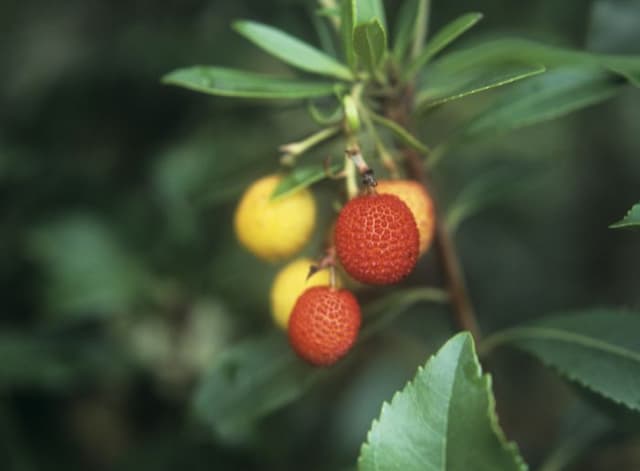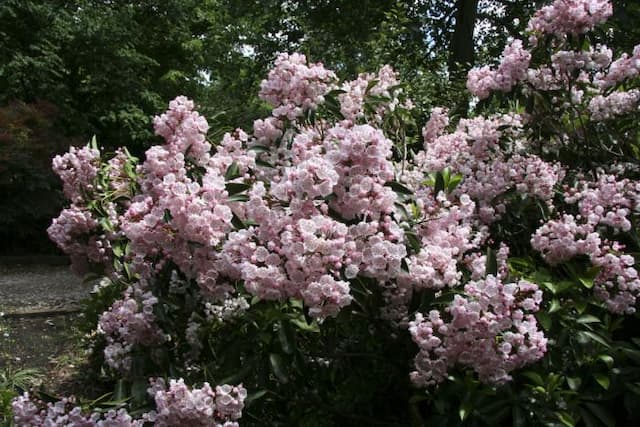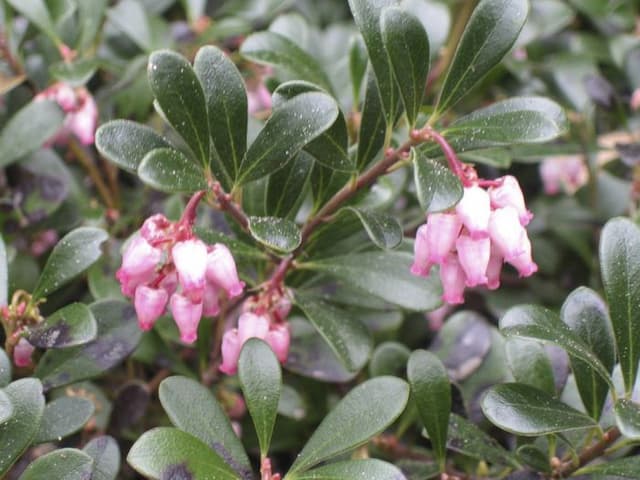Blueberry Vaccinium corymbosum (F)

ABOUT
Vaccinium corymbosum, commonly known as the highbush blueberry, is a deciduous shrub with a dense, multi-branched habit. It is well-regarded for its beautiful appearance throughout the year, offering interest in every season. The plant's leaves are broad, elliptical, and green, with a subtle, attractive texture on the surface. During the fall, the foliage transforms into striking shades of crimson and orange, making it a standout in the landscape. The highbush blueberry is also admired for its flowers. In spring, it produces delicate, bell-shaped white flowers that hang in small clusters. These dainty flowers attract pollinators and are a prelude to the plant's fruit. The fruit of the highbush blueberry is perhaps its most desirable feature. The berries are small, round, and boast a deep blue hue with a light, protective powdery coating known as bloom. These berries not only provide a visual contrast against the green leaves but are also a favored treat for both wildlife and humans because of their sweet flavor when ripe. The highbush blueberry's bark is also of note – it is smooth when young and, as it ages, becomes slightly ridged and may peel in strips, adding to its winter interest. Overall, the highbush blueberry is a versatile plant that adds beauty to any space throughout its seasonal changes.
About this plant
 Names
NamesFamily
Ericaceae.
Synonyms
Highbush Blueberry, Swamp Blueberry, Tall Huckleberry, High Blueberry, Blue Huckleberry.
Common names
Cyanococcus corymbosus (L.) Rydb., Vaccinium constablaei A.Gray, Vaccinium atrococcum A.Gray, Vaccinium corymbosum var. albiflorum Hook.f., Vaccinium corymbosum var. atrococcum (A.Gray) A.Gray, Vaccinium corymbosum var. glabrum A.Gray, Vaccinium corymbosum var. pallidum Aiton.
 Toxicity
ToxicityTo humans
Vaccinium corymbosum is commonly known as the highbush blueberry. Highbush blueberry is not toxic to humans, and in fact, its berries are widely consumed as a nutritious fruit. There are no well-documented cases of poisoning from consuming highbush blueberries or any other parts of the plant in normal food quantities. However, like with any food, overconsumption can potentially lead to gastrointestinal discomfort due to excessive fiber intake.
To pets
Vaccinium corymbosum, commonly known as the highbush blueberry, is not toxic to pets, including dogs and cats. In fact, blueberries are often recommended as a healthy treat for pets in moderation due to their antioxidant properties. There are no typical symptoms of poisoning from highbush blueberry as it is generally considered safe for pet consumption. However, as with any dietary change or treat, introducing highbush blueberries to a pet's diet should be done cautiously to prevent gastrointestinal upset.
 Characteristics
CharacteristicsLife cycle
Perennials
Foliage type
Deciduous
Color of leaves
Green
Flower color
White
Height
6-12 feet (1.8-3.7 meters)
Spread
6-12 feet (1.8-3.7 meters)
Plant type
Shrub
Hardiness zones
5-8
Native area
North America
Benefits
 General Benefits
General Benefits- Nutritional Value: Vaccinium corymbosum, commonly known as blueberry, is a rich source of vitamins and minerals, particularly Vitamin C and K, providing essential nutrients for a healthy diet.
- Antioxidant Rich: Blueberries contain high levels of antioxidants such as flavonoids and anthocyanins that help protect the body from oxidative stress and support overall health.
- Dietary Fiber: Blueberries are a good source of dietary fiber, which aids in digestion and helps maintain a healthy gastrointestinal tract.
- Wildlife Habitat: Blueberry bushes provide shelter and food for various wildlife species, including birds and beneficial insects.
- Landscape Aesthetics: As an ornamental plant, blueberries offer attractive foliage and flowers, enhancing the beauty of gardens and landscapes.
- Erosion Control: The root system of blueberry plants helps stabilize soil and prevent erosion, particularly on slopes and in garden settings.
- Pollinator Support: Blueberry flowers attract bees and other pollinators, which are vital for the pollination of many plants and crops.
 Medical Properties
Medical Properties- Antioxidant activity: Contains high levels of anthocyanins and other flavonoids that can help scavenge free radicals.
- Cardiovascular health: May contribute to the maintenance of healthy cholesterol levels and overall heart health.
- Anti-inflammatory properties: The bioactive compounds found in the berries may reduce inflammation.
- Glycemic control: May have a role in managing blood sugar levels, beneficial for those with diabetes or at risk of diabetes.
- Cognitive function: Some studies suggest that consuming these berries can help improve memory and cognitive performance.
- Urinary tract health: Like cranberries, a close relative, they may aid in preventing urinary tract infections.
- Vision health: Contains nutrients that are thought to protect the eyes and improve vision health.
- Immune support: High vitamin C content and other immune-boosting nutrients can help support the immune system.
- Anticancer potential: Some studies imply that the compounds in the berries could have anticancer properties, although more research is needed.
 Air-purifying Qualities
Air-purifying QualitiesThis plant is not specifically known for air purifying qualities.
 Other Uses
Other Uses- Natural Dye: The fruit of the highbush blueberry can be used to create a natural dye for textiles or crafts, giving fabrics a soft purple or blue hue.
- Wildlife Habitat: Highbush blueberry bushes provide shelter and breeding habitats for various bird species and small mammals.
- Baking: Beyond the typical pie or muffin, highbush blueberry fruits can be used in a wide range of baked goods, including breads, pancakes, and even scones, for a natural sweet flavor.
- Landscape Design: Due to their attractive flowers and colorful fall foliage, highbush blueberries can be incorporated into ornamental garden landscapes.
- Photography Prop: The picturesque highbush blueberry plant with its seasonal transitions makes a beautiful subject for nature and macro photography.
- Educational Use: These plants can be used in educational settings to teach botany, plant life cycles, and sustainable agriculture practices.
- Leaf Prints: Leaves of the highbush blueberry can be used to create detailed leaf prints in art projects, using their natural shapes and vein patterns.
- Fragrance: The delicate, sweet aroma of highbush blueberry blossoms and fruits can inspire natural fragrances or be used in potpourri.
- Berry Picking Attraction: Farms with highbush blueberries can offer pick-your-own opportunities, attracting visitors for recreational and educational purposes.
- Bird Watching: Planting highbush blueberries can attract a variety of bird species, making it an attraction for birdwatchers.
Interesting Facts
 Feng Shui
Feng ShuiThe Blueberry is not used in Feng Shui practice.
 Zodiac Sign Compitability
Zodiac Sign CompitabilityThe Blueberry is not used in astrology practice.
 Plant Symbolism
Plant Symbolism- Longevity and Eternity: Vaccinium corymbosum, commonly known as the highbush blueberry, represents longevity and eternity due to its perennial nature and the longevity of the plant itself, which can produce fruit for several decades.
- Abundance and Prosperity: The fruit-heavy shrubs symbolize abundance and prosperity, reflecting the generous yield of berries that the plant can offer, thus bearing the notion of fruitfulness in various aspects of life.
- Native American Heritage: Given its North American origins, the highbush blueberry holds symbolism connected to Native American heritage, as it was a staple and medicinal plant for indigenous people, representing a deep respect for the land and its native species.
- Health and Well-being: Because blueberries are rich in antioxidants and widely considered a superfood, the highbush blueberry represents health and well-being, embodying the idea of nurturing and taking care of one’s physical health.
 Water
WaterFor highbush blueberry plants, maintain consistent moisture, especially during the growing season. They should be watered about 1 to 2 inches per week. Mulching can help retain moisture. During dry spells, possibly increase watering, but do not let the soil become soggy. Overhead watering can help simulate natural rainfall. During winter, reduce watering, but do not let the plants dry out completely.
 Light
LightHighbush blueberry plants thrive in full sunlight. They perform best in a location where they can receive at least 6 to 8 hours of direct sunlight daily. However, in regions with extremely hot summers, they can benefit from light afternoon shade to prevent overheating.
 Temperature
TemperatureHighbush blueberry plants prefer a temperate climate with a winter chill to ensure proper dormancy. They can survive temperatures as low as 20 degrees Fahrenheit and as high as 85 degrees Fahrenheit. The ideal temperature range for these plants is between 60 and 75 degrees Fahrenheit.
 Pruning
PruningPruning highbush blueberry plants is essential for maintaining plant health, encouraging strong growth, and increasing fruit production. Prune annually during the dormant season, ideally in late winter. Remove dead or diseased branches, and thin out crowded areas to improve air circulation.
 Cleaning
CleaningAs needed
 Soil
SoilBlueberry plants thrive in acidic soil with a pH of 4.5 to 5.5. A well-draining mix with peat moss, sand, and pine bark is ideal. Ensure consistent moisture without waterlogging.
 Repotting
RepottingBlueberry plants need repotting every two to three years or when they outgrow their current pots. Early spring is the best time for repotting.
 Humidity & Misting
Humidity & MistingBlueberry plants prefer moderate humidity but are adaptable to various conditions. Aim for about 40-60% relative humidity for optimal growth.
 Suitable locations
Suitable locationsIndoor
Provide acidic soil, sunlight, and keep soil moist.
Outdoor
Full sun, acidic soil, water regularly.
Hardiness zone
3-8 USDA
 Life cycle
Life cycleVaccinium corymbosum, commonly known as highbush blueberry, begins its life cycle when seeds germinate in spring, requiring a period of stratification to break dormancy. Seedlings emerge and develop into juvenile plants, forming an extensive root system and vegetative growth, primarily in the form of woody canes and broad, deciduous leaves. After 2-3 years, the juvenile plants mature and enter the reproductive stage, producing clusters of white or pink bell-shaped flowers which, upon pollination by bees and other insects, develop into small green berries. These green berries mature over the summer, turning blue and succulent when ready to be harvested. Following fruiting, the plant enters a period of senescence in autumn where leaves change color and fall off, and it undergoes dormancy during the winter months. In early spring, the cycle begins anew with the plant breaking dormancy and initiating new vegetative growth.
 Propogation
PropogationPropogation time
Spring-Early Summer
The most popular method of propagation for the Vaccinium corymbosum, commonly known as the highbush blueberry, is through softwood cuttings. This is typically done in late spring or early summer when new growth is still tender and flexible. Cuttings about 4 to 6 inches long are taken from the current year’s growth. The bottom inch of each cutting is dipped in rooting hormone to facilitate root development. The treated cuttings are then inserted into a well-draining growing medium such as a mixture of peat and perlite, ensuring at least two sets of leaves remain above the surface. The cuttings are kept under high humidity, often with the use of mist systems, and in indirect light until roots have developed, which generally takes several weeks. After rooting, they can be transplanted to individual pots and grown on before planting out.









